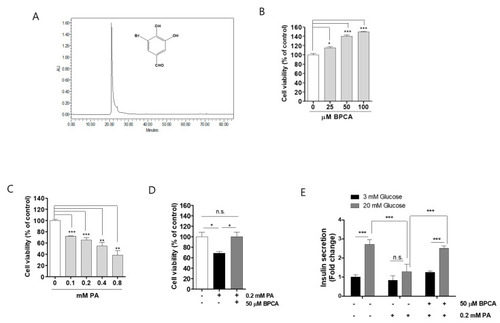Figure 1
- ID
- ZDB-FIG-210303-52
- Publication
- Cha et al., 2021 - 5-Bromoprotocatechualdehyde Combats against Palmitate Toxicity by Inhibiting Parkin Degradation and Reducing ROS-Induced Mitochondrial Damage in Pancreatic β-Cells
- Other Figures
- All Figure Page
- Back to All Figure Page
|
5-Bromoprotocatechualdehyde (BPCA) isolated from Polysiphonia japonica combats palmitate-induced toxicity and dysfunction in Ins-1 cells. (A). Chemical structure and high-performance liquid chromatography (HPLC) purity profile of BPCA. (B). Ins-1 cells were incubated with the indicated concentrations of BPCA (25, 50, and 100 µM) for 24 h. (C). Ins-1 cells were incubated with the indicated concentrations of palmitic acid (PA) (0.1, 0.2, 0.4, and 0.8 mM) for 24 h. (D). Ins-1 cells were incubated with 50 µM BPCA for 1 h and then further incubated with/without 0.2 mM PA for 24 h. CCK-8 assays were subsequently performed as described in “Materials and Methods”. (E). Ins-1 cells were incubated with 50 µM BPCA in 5 mM glucose media for 1 h and then further incubated with or without 0.2 mM PA for 24 h. Thereafter, the cells were starved in 0.2 mM glucose-containing Krebs–Ringer bicarbonate (KRB) buffer for 2 h. Insulin release was measured after 2 h of incubation in either 3 or 20 mM glucose. ELISA assays for insulin were subsequently performed. Data are expressed as the fold change from untreated cells in 3 mM glucose. * p < 0.05, ** p < 0.01, *** p < 0.001, n.s. = no significance. |

